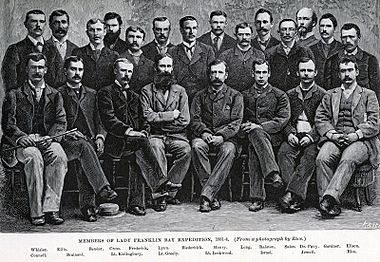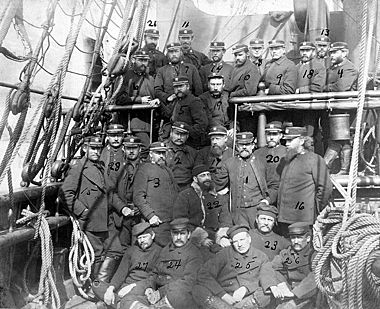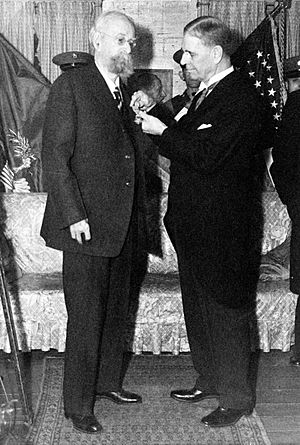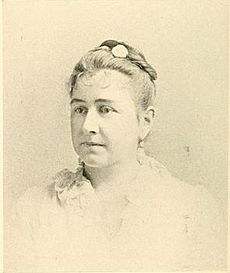Adolphus Greely facts for kids
Quick facts for kids
Adolphus Greely
|
|
|---|---|
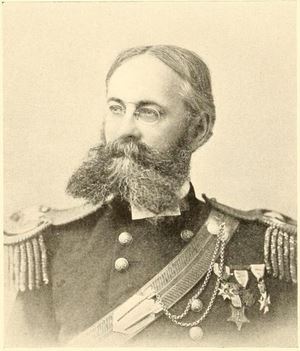
Greely in 1895
|
|
| Birth name | Adolphus Washington Greely |
| Born | March 27, 1844 Newburyport, Massachusetts |
| Died | October 20, 1935 (aged 91) Washington, D.C. |
| Buried | |
| Allegiance | |
| Branch | |
| Service years | 1861–1908 |
| Rank | Major General |
| Commands held | Lady Franklin Bay Expedition Chief Signal Officer of the U.S. Army Pacific Division Northern Division Department of the Columbia Department of Dakota |
| Battles/wars | American Civil War American Indian Wars Spanish–American War Philippine–American War |
| Awards | Medal of Honor |
| Spouse(s) | Henrietta Nesmith (m. 1878-1918, her death) |
| Children | 7 (including Rose Greely) |
| Signature | |
Adolphus Washington Greely FRSGS (March 27, 1844 – October 20, 1935) was an officer in the United States Army. He was also a famous polar explorer. He reached the high rank of major general. He also received the Medal of Honor for his amazing service.
Greely was born in Newburyport, Massachusetts. He joined the Union Army in 1861 during the American Civil War. He quickly moved up in rank. After the war, he continued his military career.
In 1881, he led a group of 25 men on an Arctic exploration. This trip was called the Lady Franklin Bay Expedition. The team faced many challenges, including a lack of food. Rescue missions failed to reach them. By the time they were rescued in 1884, only six men, including Greely, were still alive.
Later, Greely became the Army's Chief Signal Officer. In this role, he helped set up communication networks around the world. These networks were very important during wars like the Spanish–American War. He retired from the Army in 1908. In 1935, he received the Medal of Honor for his long and excellent public service.
Contents
Early Life and Military Start
Adolphus Greely was born in Newburyport, Massachusetts. This was on March 27, 1844. He went to Brown High School, which is now Newburyport High School. In 1861, he joined the Union Army. This was during the American Civil War. He served in the 19th Massachusetts Infantry Regiment. He quickly rose through the ranks. He became a first sergeant.
Moving Up in the Army
In 1863, Greely became a second lieutenant. He was promoted to first lieutenant in 1864. In 1865, he became a captain. After the war, he earned a special promotion to major. This was for his great service during the war.
During the Civil War, Greely fought in several battles. These included Ball's Bluff and Antietam. After the war, he helped with the occupation of New Orleans.
Working with the Signal Corps
In 1867, Greely joined the Regular Army. He was later assigned to the Signal Corps. This happened from 1871 to 1880. He was promoted to first lieutenant in 1873.
The Signal Corps also included the Weather Bureau. Greely became known as a skilled weather forecaster. He helped map out flood areas of major rivers. This helped with flood control projects. He also oversaw building telegraph lines. These lines were in many remote areas.
The Lady Franklin Bay Expedition
In 1881, Greely was chosen to lead the Lady Franklin Bay Expedition. This trip was part of the first International Polar Year. Its goal was to set up weather stations. The team also collected data about the stars and Earth's magnetism. They also looked for clues about a lost ship, the USS Jeannette.
The expedition sailed on the ship SS Proteus. Greely had no Arctic experience before this. But his team explored much of northwest Greenland. They also crossed Ellesmere Island. Two of his men, James B. Lockwood and David Legge Brainard, reached a new "farthest north" record. Greely also discovered and named the Conger Range mountains.
Challenges in the Arctic
Greely's group faced big problems. Two supply ships failed to reach them. This happened in 1882 and 1883. Greely decided to leave their base, Fort Conger. They traveled south to Cape Sabine. They hoped to find food there. But the supplies had not been left for them. Winter was coming, and they had little food or fuel.
A rescue team was sent to find them. It was led by Captain Winfield Scott Schley. By the time the rescue ships arrived in June 1884, 18 of Greely's 25 men had died. They died from hunger, cold, or drowning. One soldier was punished for repeatedly stealing food.
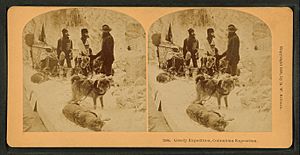
Greely and the other five survivors were very weak. One more died on the way home. People saw them as heroes. There were some rumors about what happened, which Greely denied. An exhibit about the expedition was shown at the Columbian Exposition in 1893.
Later Career and Achievements
In 1887, President Grover Cleveland made Greely the Chief Signal Officer of the U.S. Army. He became a brigadier general. As Chief Signal Officer, he oversaw building many telegraph lines. These were important during the Spanish–American War. He built lines in Puerto Rico, Cuba, and the Philippines. He also built a huge telegraph system in Alaska. This system included underwater cables and wireless telegraphy. It was one of the longest in the world at that time.
Greely brought many new ideas to the Signal Corps. He helped the Army use wireless telegraphy, airplanes, and motor vehicles. He represented the U.S. at international meetings about telegraphy. He helped create the first international agreements on telecommunications.
In 1906, he was promoted to major general. He commanded the Pacific Division. He also led the relief efforts after the San Francisco earthquake. Greely retired from the Army in 1908.
Family Life
In 1878, Greely married Henrietta Nesmith. They were married until her death in 1918. Henrietta was also involved in historical societies. They had seven children together. Six of them lived to be adults. Their children included:
- Antoinette (1879–1968), a social worker.
- Adola (1881–1961), who married a reverend.
- John (1885–1965), who became an Army brigadier general.
- Rose, a well-known landscape architect.
- Adolphus (1889–1956), an engineer and Army major.
- Gertrude (1891–1969), who married a doctor.
Awards and Recognition
Military Awards
 Medal of Honor
Medal of Honor Purple Heart with oak leaf cluster
Purple Heart with oak leaf cluster Civil War Campaign Medal
Civil War Campaign Medal Indian Campaign Medal
Indian Campaign Medal Spanish War Service Medal
Spanish War Service Medal
Greely received the Medal of Honor in 1935. This award was for "his life of splendid public service." He was one of the few people to get this award for a lifetime of service. It was not for a single act of bravery.
During the Civil War, Greely was wounded twice. He received the Purple Heart medal for these injuries.
Civilian Awards
Greely also received several civilian awards. These included the Royal Geographical Society's Founder's Medal in 1886. He also got the Roquette Medal from the Societe de Geographie. In 1922, he received the American Geographical Society's Charles P. Daly Medal.
Legacy
Greely died in Washington, D.C., on October 20, 1935. He was buried at Arlington National Cemetery.
A transport ship, USS General A. W. Greely (AP-141), was named after him. Fort Greely, an Army base in Alaska, was also named in his honor. There was an earlier Fort Greely on Kodiak Island, Alaska, also named for him.
See Also
 In Spanish: Adolphus Greely para niños
In Spanish: Adolphus Greely para niños
- Greely Island
- List of Medal of Honor recipients during Peacetime
Works
Greely wrote several books and articles about his experiences:
- Three Years of Arctic Service (1886)
- Handbook of Alaska (rev. ed. 1925)
- Reminiscences of Adventure and Service (1927)
- The Polar Regions in the Twentieth Century (1928)



